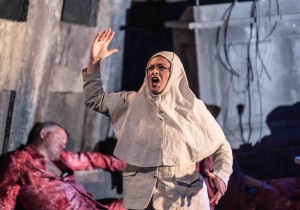The main attraction of this revival of the 2007 production of Khovanshchina is the much-anticipated conducting of Mussorgsky’s gargantuan score from WNO’s new music director Tomáš Hanus.
That and the chance to again revel in the glorious WNO chorus in a work that gives the men and women such a fabulous platform for showing just why they are the jewels in the company’s musical crown, whatever directors throw at them.
Mark Le Broq as Prince Vasily Golistyn
On both counts the rather depleted audience at Wales Millennium Centre (what happened to the days when every opera, every performance sold out?) was not to be disappointed.
Hanus brings out the conflicting or at least contrasting violence and beauty, power and subtlety that is unrelenting in this epic work that was completed by Rimsky-Korsakov, here the Shostakovich orchestrated version. The work had not been completed when Mussorgsky died.
There is no shying away from the ugly and barbaric story and the seemingly paradoxical gentleness and lyricism of much of the singing. It is based on 17th century Russian history but such is the complexity the story is exceptionally difficult to tell. The opera stands or falls on the quality of playing and singing. Here it is in secure hands with the chorus and orchestra of WNO. This is all just as well seeing that the narrative itself remains baffling even with knowledge of what was the last throes of the Byzantine Russian world, when what was seen as the inheritors of the Roman mantel were dragged, literally kicking and screaming, into the early modern Europe.
While David Pountney and designer Johan Engels do their best to delineate characters and factions with simple use of different coloured costumes, and plonks the action into a Soviet revolutionary world (complete with a duma building smashed open with a wrecking ball) to smack us in the face with a contemporary analogy, the opera remains a dramatic mess.
Robert Hayward as Prince Khovansky and Elena Thomas as the Persian Slave
Sara Fulgoni singing Marfa and Miklós Sebestyén singing Dosifel
It is all theatrically entertaining and the interpretation is all straightforward. There is, of course, lashings of Pountney excess in the treatment of sexual abuse against women. There is little room for sensuality when chem sex, nudity, bondage and graphic phallic imagery can be employed. In some ways the women are the strongest characters in the opera but the disturbed portrayal of sex isn’t really helpful.
At the start of the opera the presence of a huge demolition ball ominously hanging over the set will remind those familiar with popular culture of Miley Cyrus’ ‘infamous Wrecking Ball video. For the Dance of the Persian Slave it has been lowered to the ground and the naked dancer cavorts upon it in a way that make the pop singer’s video look like a Disney channel offering. Elena Thomas, who has done such great work with National Dance Company Wales, dances wonderfully whatever you think of the damaged sexualisation of the role.
Adrian Dwyer as Prince Andrei Khovansky
But such fun does not detract from the singing, the chorus is usually allowed to stand and sing, while special mention must be made of Monika Sawa who was just knock out as Susanna.
The chorus is most impressive when singing the thuggish private army the Streltsy and then the doomed Old Believers who choose suicide to preserve their religious purity.
The cast is well-balanced and secure in their roles with a powerful Robert Hayward and Adrian Dwyer singing Khovansky father and son prince Andrei contrasting with Mark Le Brocq as the modernising and here artistically modernist Prince Golitsy.
There is mesmerising singing from Miklos Sebestyen as Dosifei the leader of the traditionalists who oppose reforms of the unseen Patriarch Nikon and Simon Bailey as Shaklovity the agent of the also unseen Romanov tsarina regent and her two sons Peter and Ivan.
The most difficult characterization is Marfa, sung by Sara Fulgoni, a victim continuously berating her lot having been shunned by Prince Andrei and trying to save his soul through her own adherence to the old ways which leads them both to the gas chamber. I did say this was a David Pountney production.
Simon Bailey as Shaklovity
Monika Sawa singing Susanna
Further performances at Wales Millennium Centre, Cardiff, Saturday and October 7, then touring to Venue Cymru, Llandudno and Hippodrome, Birmingham. wno.org.uk
CREDIT: CLIVE BARDA/WNO
WNO Eugene Onegin review:
http://asiw.co.uk/reviews/eugene-onegin-welsh-national-opera-wmc
So what is Arts Scene in Wales?





